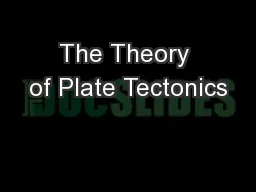

Plate Tectonics Became a theory in the 1960s Describes plate movements AND explains why they move Plate Tectonics Two types of crust Oceanic and Continental Plates are usually made of both ID: 655098
Download Presentation The PPT/PDF document "The Theory of Plate Tectonics" is the property of its rightful owner. Permission is granted to download and print the materials on this web site for personal, non-commercial use only, and to display it on your personal computer provided you do not modify the materials and that you retain all copyright notices contained in the materials. By downloading content from our website, you accept the terms of this agreement.
Slide1
The Theory of Plate TectonicsSlide2
Plate Tectonics
Became a theory in the 1960’s
Describes plate movements AND explains why they moveSlide3
Plate Tectonics
Two types of crust: Oceanic and Continental
Plates are usually made of both
Plates: Chunks of lithosphere “floating” around on the
asthenosphereSlide4Slide5Slide6
Plate Boundaries
Three Types:
Divergent Boundaries: two plates moving away from each other
Plates move apart, molten rock from
asthenosphere
fills gap
Most found on ocean floor (mid-ocean ridges)
Rift valley: valley in the center of the mid-ocean ridgeSlide7
Divergent BoundarySlide8Slide9
Convergent Boundaries
Two plates colliding (Three types of collisions)
Ocean – Continental: ocean crust is denser, so it is
subducted
:
forced under the continental crust
Ocean trench forms
Subducting
crust melts, some rises through the continental crust to form volcanic mountainsSlide10Slide11
Convergent Boundaries
Continental-Continental: neither is
subducted
, but both are crumpled and uplifted, forming mountain rangesSlide12
Convergent Boundaries
Oceanic-Oceanic: one plate gets
subducted
, again forming an ocean trench
Melting crust rises to form a volcanic
island arcSlide13Slide14
Transform Fault Boundaries
Sliding and grinding past each other
Does not move smoothly – spurts of movement between periods of no motionSlide15Slide16
Causes of Plate Motion
Convection
Hot
asthenosphere
rises, cools, sinks
convection currents
Lithospheric
plates ride on top of these conveyer belts
Evidence: More heat near divergent plate boundaries than elsewhere along ocean floorSlide17Slide18
Causes of Plate Motion
Ridge Push
New rock at mid-ocean ridges is hot, less dense, rises higher
As it cools, it sinks away from the ridgeSlide19
Causes of Plate Motion
Slab Pull
When a plate
subducts
and sinks, it pulls the rest of the plate with it